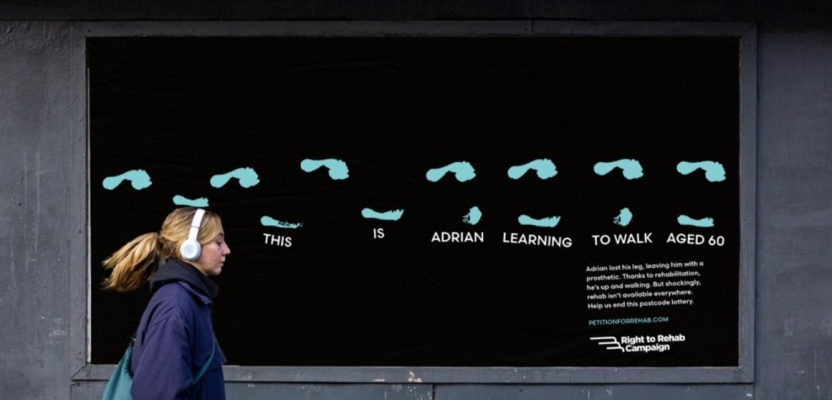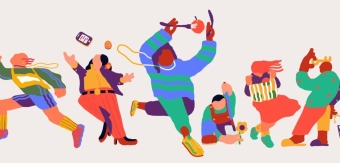A major new billboard and digital radio campaign launched last month by creative agency Pablo and intensive care rehabilitation nurse Kate Tantam, calls for an end to the postcode lottery for NHS rehabilitation services that help people recover from the likes of car crashes, cancer or strokes. There is currently no guaranteed access to this vital care.
To highlight just how important rehab is and to help end this postcode lottery, the Pablo team travelled to rehab centres, hospitals and intensive care units in Plymouth and documented a series of ‘patient firsts’ that were only possible thanks to rehabilitation – these ‘firsts’ include the first tentative footsteps or first halting words – monumental milestones for those lucky enough to receive specialist rehabilitation care.
Starting with patients’ ‘first steps', the patients’ feet were painted with safe, non-slip paint and their very first footsteps since their hospitalisation were captured on sheets of vinyl which have now been transformed and immortalised on billboard posters calling for rehab provision for all. Members of the public can actually see and touch the real footprints at poster sites throughout the UK.
And footsteps weren’t the only ‘firsts’ that were captured. In a powerful digital radio advert, a patient whose accident left them unable to speak, uses their faltering first words post-rehab to appeal to the public to support the campaign. The radio features voiceover and a call to action by Richard Hammond who relied on rehab to get back on his feet after a crash whilst filming Top Gear in 2006.
To learn more about the campaign, we spoke to Dan Watts, ECD at Pablo.
What was the brief?
The brief came rather organically from a conversation between NHS nurse Kate Tantum and our MD Harriet Knight. Kate was on a mission to promote rehabilitation and the “Rehab Legends” that provide it, through an online campaign sharing patient stories.
She wanted to get the conversation around rehabilitation to a national level owned by NHS England and promote its impact and its value to patients. Rehabilitation is so vital to so many people, yet it is a postcode lottery in the UK and not available to everybody. This brief sought to change that by getting to a talked about campaign idea on a very small budget.
How did the initial pitch/brainstorming phase go?
From the initial discussion with Kate, our creative team Matt Leach and Jess Oudot got involved with the mission and looked closely at the stories around the nurses and the patients, meeting them and listening to them.
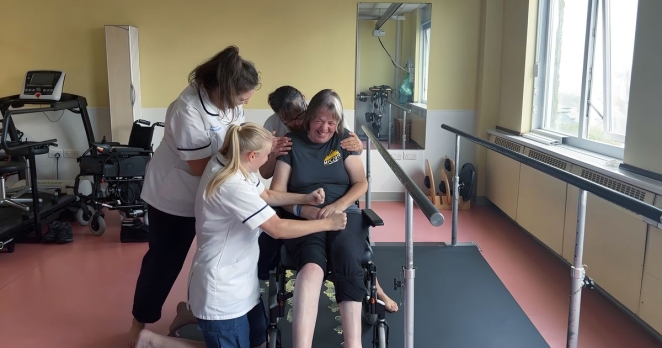
Obviously, these stories were incredibly moving. We needed to show people the emotional benefit of what rehabilitation does in a way that anybody could relate to and in a way that would stand out and encourage them to act.
What was the process behind ideating the concept?
The creative process happened quite naturally from getting into hospitals and seeing first hand the effect rehab has. It literally gives people their life back. They learn how to walk again. To talk again. It’s an incredibly emotional thing to witness in the same way a child’s first step or first words are.
These are emotions we can all relate to, and to see nurses give that gift to an adult, as a parent would a child, is incredibly powerful. This led to Matt and Jess coming up with the idea of showing these ‘firsts’. First steps since an accident immortalised in paint and turned to posters. First words since a stroke, used as a radio recording for all to hear, all pointing to the government for more funding in a bid to end the postcode lottery on rehab.
What was the production process like?
Our Head of Production Tom Moxham, would describe it as “involved!”. We wanted to have control and heavy involvement on how it came to life, so we didn’t go through a third party production Company, we assembled a team. Tom found a great Art Department lead who helped us R&D how to get to the thickest paint possible, whilst balancing safety of the patients.
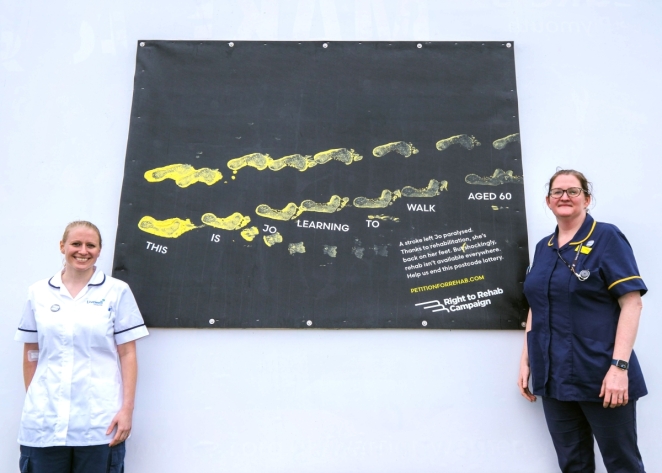
The point of the work was that we weren’t digitally reproducing the billboards, we wanted people to see up close just how real these footprints were so it felt more powerful, and therefore resonated more. Every single run of footprints is 100% authentic and true to the form the Patient walked them in.
What was the biggest challenge during production? How did you overcome it?
Logistics funnily enough. Capturing the footsteps was daunting, because these were patients who in some cases had only just come off an operating table a few days before.
So, doing everything we could to make sure they were at ease, and importantly, safe, was our paramount focus. But then moving the units back to London from Plymouth, and then onwards to all the billboard sites across the country was the biggest challenge, as they just felt so precious, and we quickly realised how easily they could scuff or mark.
Our Head of Production, Tom, ended up moving the units around London personally with a man in a van when we were getting them weatherproofed and the copy laid up, in part just because we were so invested in them looking the best they could be!
What kit/tools/software were used to create the project?
Nothing advanced at all. That’s actually what was so lovely about it, it was a very physical labour of love, mixing paint colours to eye, working out the best mix of paint material with things like glue and sand. It was a really tactile process, and I think that comes through in the finished product. There are imperfections, and that feels right for the idea.
What is one funny or notable thing that happened during production?
One notable thing about production was just the resilience and determination of everyone involved. From the patients who walked their first steps for us and shared their stories to the team on the ground doing the production. We did the production in the middle of storm Babet.
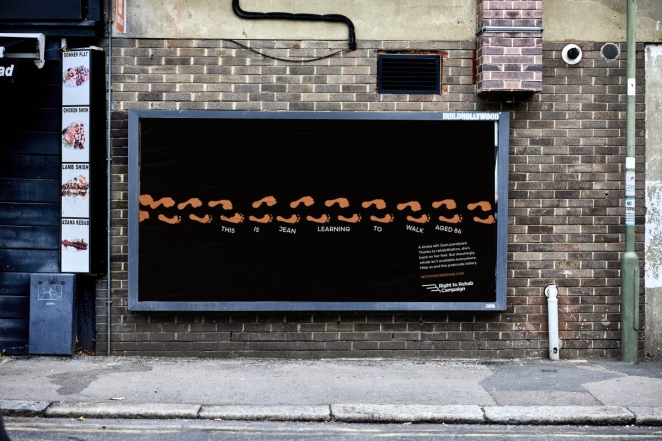
Our senior account lead Lucy Manchin got stranded at various train stations in the South West and had to carry heavy vinyl panels with wet paint through the rain. The van was too tall for the hospital loading dock. Our producer broke his ankle on the first day. We had only 5 minutes of recording time with Richard Hammond and experienced technical difficulties.
Despite all of this we ended up with a media first campaign that we feel so proud of and hope encourages change in the NHS provisions throughout the UK.
How long did it take from inception to delivery?
Inception started on the 24th June 2022 and we delivered the final campaign on the 19th February, 2024. So, 20 months from start to finish.
What is the main message/What do you hope it achieves for the brand?
First of all we want to raise awareness of the shocking postcode lottery that is rehab access in the UK.
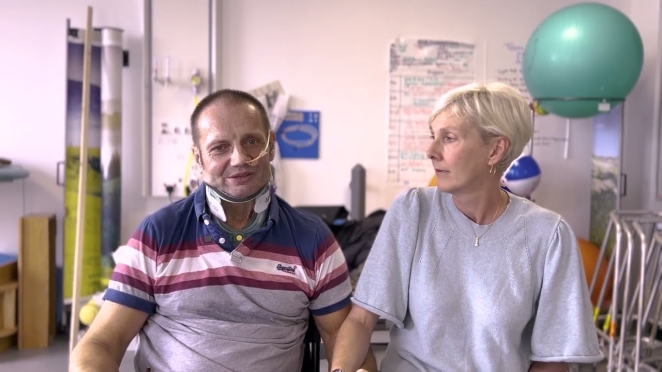
And we want to reach 100,000 signatures on the petition so that we can take it to the government to enact a real change in the provisions so that everyone, no matter their condition and where they live, has access to rehab.
Credit list for the work?
Executive Creative Director: Dan Watts
Managing Creative Directors: Ray Shaughnessy and Dan Norris
Creative Team: Jess Oudot and Matt Leach
Managing Director: Harriet Knight
Account Director: Lucy Machin
Head of Production & Producer: Tom Moxham
Project Director: Mandi Nixon
Editor: Oliver Goodrum
Designer: Mark Harrison
Artwork: Viren Patel
